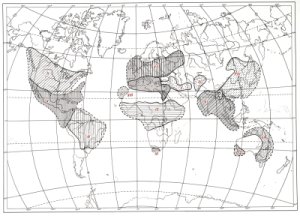 |
QUICK SEARCH
MO PROJECTS:
Africa
Asia/Pacific
Mesoamerica
North America
South America
General Taxonomy
Photo Essays
Training in Latin
America
MO RESEARCH:
Wm. L. Brown Center
Bryology
GIS
Graduate Studies
Research Experiences
for Undergraduates
Imaging Lab
Library
MBG Press
Publications
Climate Change
Catalog Fossil Plants
MO DATABASES:
W³MOST
Image Index
Rare Books
Angiosperm
Phylogeny
Res Botanica
All Databases
INFORMATION:
What's New?
People at MO
Visitor's Guide
Herbarium
Jobs & Fellowships
Symposium
Research Links
Site Map
Search
THE ORIGIN OF GARDEN PLANTS AND THE FSU CONTRIBUTION
The number of ornamentals used by horticulturists far exceeds the total number of species and varieties of all other known economically useful plants. It is practically impossible to establish their exact numbers since new cultivars appear constantly in all corners of the globe, and there is no existing universally accepted system to register them promptly and permanently. It is possible, however, to get an approximate count of the number of plant species. Preliminary calculations reveal that there are about eight thousand species of ornamentals available in commercial trade catalogues today. This total of garden plants can be divided into three groups. The first consists of species from which cultivars appear most frequently in trade catalogues and are considered commercial stock. All species belonging to this group have many cultivars, sometimes tens of thousands, as of the most popular garden plants such as Gladiolus, Iris, Narcissus, Rosa, Tulipa etc. and are grown over large areas. But at the same time, the actual number of species in this group is not great. For instance, most of cultivars of herbaceous plants that are grown outdoors in the Temperate zone arise from only about 120 perennial and 100 annual species. The most popular of the perennials are: peony, phlox, iris, lily, tulip and daffodil. Among the annuals the greatest diversity can be found in the China aster (Callistephus chinensis), Petunia, and marigolds (Tagetes spp.). Similarly, among the woody plants, the Rose, Rhododendron, and Clematis are exceptional in their diversity of form. Apart from the commercial stock, there is a second group of woody and herbaceous species that, though cultivated to a much lesser extent, frequently occur in our gardens and parks. These plants display less diversity in their cultivated forms than the aforementioned group. The two groups, together, cover about 5,000 species. A third group of about 3,000 species are mentioned in only a few trade catalogues. Among them are many wild species that have been subjected to only initial selection. All three groups consists of the species taken from different continents. Some of the earliest reliable research on the geographical origin of cultivated plants can be found in the work of De Candolle (1855). His studies of 247 species of cultivated plants established that 50 of them have a history dating back five to six thousand years. He also determined that most of these useful plants originated in the "Old World," (Europe, Asia and North Africa). Later on, many biologists, including Charles Darwin, studied the history of domestic animals and plants. The fundamental investigations regarding cultivated plant origin were done by Russian scientist, N. I. Vavilov (1926). He made a comprehensive study of the origin of cultivated plants, and proposed that there were eight world centers of ancient civilization, at which the greatest concentration of diversity in cultivated plant species and their varieties (cultivars) occurred; unfortunately, he excluded ornamentals from his investigation. Since then many scientists have investigated the origin of economically useful plants as a whole and ornamentals in particular. Among the authors who have contributed to identifying the centers of origin of ornamental plants are: Basilevskaya (1960), who investigated the geographical origin of garden plants; Coats (1968), who traced the history of ornamentals, especially herbs; Fisher (1982), who described how many ornamentals were taken from nature; and Hui-Lin Li (1974), who wrote about the introduction of woody plants. These papers and analysis of the origin of the 5,000 species (mentioned above) used in horticulture made it possible to establish the centres of origin of ornamental plants. Therefore, the regions described below have been arranged according to the geographical distribution of the wild species of common garden plants. In many cases Vavilov's centres were used as a base. Thirteen centers (instead of eight for economic plants) can now be defined for ornamental plants. Although the division into regions is a fundamental one, the fact that in this study the bulk of ornamentals were taken into consideration allows us to regard this divisions as reliable. The determination of the floristic regions is based on the system proposed by Takhtajan (1978, 1986). The centers of origin of ornamental plants presented here are given according to importance. The contribution of each range, i.e. the number of ornamental species discovered in each range and its proportion of the total amount of species, has been evaluated with regard to its role in the development of the world's resources.
|
|
| ORNAMENTAL PLANTS FROM RUSSIA |
© 1995-2025 Missouri Botanical Garden, All Rights Reserved
4344 Shaw Blvd.
St. Louis, MO 63110
(314) 577-5100
Technical Support
